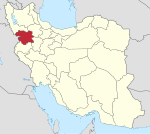Taghamin Rural District
In the article titled Taghamin Rural District, a topic of great relevance today is addressed, which has generated a wide debate and has aroused the interest of society in general. Throughout this article, different aspects related to Taghamin Rural District will be analyzed, from its origin to its impact on current society. Likewise, the different opinions and positions that exist around Taghamin Rural District will be examined, in order to offer readers a complete and objective vision of the topic. In addition, relevant data, studies and research will be presented that will contribute to enriching knowledge about Taghamin Rural District and deepening its understanding. Without a doubt, this article will be very useful for those interested in acquiring greater knowledge about Taghamin Rural District and understanding its importance in today's society.
Taghamin Rural District
Persian: دهستان طغامين | |
|---|---|
| Coordinates: 36°17′54″N 47°30′39″E / 36.29833°N 47.51083°E[1] | |
| Country | Iran |
| Province | Kurdistan |
| County | Bijar |
| District | Korani |
| Capital | Aghbolagh-e Taghamin |
| Population (2016)[2] | |
• Total | 3,137 |
| Time zone | UTC+3:30 (IRST) |
Taghamin Rural District (Persian: دهستان طغامين)[3] is in Korani District of Bijar County, Kurdistan province, Iran.[4] Its capital is the village of Aghbolagh-e Taghamin.[5]
Demographics
Population
At the time of the 2006 National Census, the rural district's population was 3,781 in 844 households.[6] There were 3,303 inhabitants in 797 households at the following census of 2011.[7] The 2016 census measured the population of the rural district as 3,137 in 908 households. The most populous of its 17 villages was Aghbolagh-e Taghamin, with 468 people.[2]
See also
References
- ^ OpenStreetMap contributors (27 December 2024). "Taghamin Rural District (Bijar County)" (Map). OpenStreetMap (in Persian). Retrieved 27 December 2024.
- ^ a b Census of the Islamic Republic of Iran, 1395 (2016): Kurdistan Province. amar.org.ir (Report) (in Persian). The Statistical Center of Iran. Archived from the original (Excel) on 8 May 2022. Retrieved 19 December 2022.
- ^ "INCSGN Search". Iranian National Committee for Standardization of Geographical Names (in Persian). Tehran: National Cartographic Center of Iran. Archived from the original on 2 May 2019.
- ^ Habibi, Hassan (2 November 2017) . Approval of the organization and chain of citizenship of the elements and units of the national divisions of Kurdistan province, centered in the city of Sanandaj. rc.majlis.ir (Report) (in Persian). Ministry of the Interior, Defense Political Commission of the Government Board. Proposal 3233.1.5.53; Letter 907-93808; Notification 83352/T130K. Archived from the original on 23 October 2018. Retrieved 22 January 2024 – via Islamic Parliament Research Center of the Islamic Republic of Iran.
- ^ Mousavi, Mirhossein (c. 2013) . Creation and formation of 11 rural districts including villages, farms and places in Bijar County under Kurdistan province. rc.majlis.ir (Report) (in Persian). Ministry of the Interior, Council of Ministers. Proposal 2214.5.53. Archived from the original on 28 April 2013. Retrieved 23 January 2024 – via Research Center of the System of Laws of the Islamic Council of the Farabi Library of Mobile Users.
- ^ Census of the Islamic Republic of Iran, 1385 (2006): Kurdistan Province. amar.org.ir (Report) (in Persian). The Statistical Center of Iran. Archived from the original (Excel) on 20 September 2011. Retrieved 25 September 2022.
- ^ Census of the Islamic Republic of Iran, 1390 (2011): Kurdistan Province. irandataportal.syr.edu (Report) (in Persian). The Statistical Center of Iran. Archived from the original (Excel) on 19 January 2023. Retrieved 19 December 2022 – via Iran Data Portal, Syracuse University.


